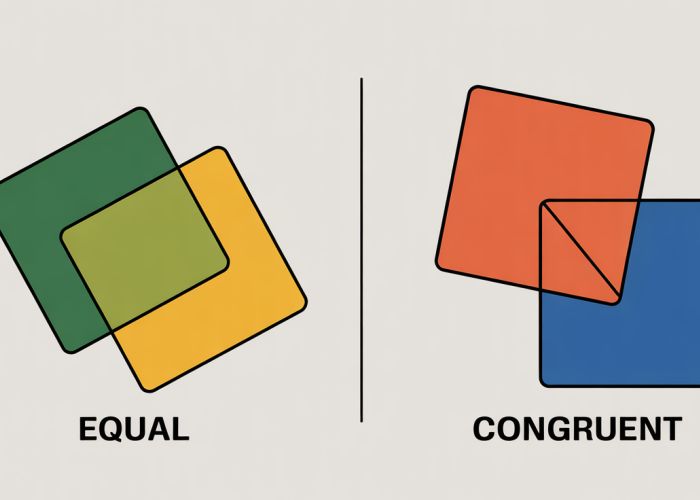Geometry, a branch of mathematics, frequently uses the concepts of equal vs congruent to describe relationships between figures. The Euclidean plane, a fundamental mathematical construct, offers a visual space for understanding these relationships. The Common Notions, articulated by Euclid, state foundational principles about equality relevant to congruence. In essence, equal vs congruent distinguishes between identical values and identical shapes with potentially different locations, impacting fields from architecture to engineering.

Equal vs. Congruent: Deconstructing the Difference
Understanding the difference between "equal" and "congruent" is crucial, especially in mathematics and related fields. Although often used interchangeably in casual conversation, these terms possess distinct meanings. This explanation breaks down these terms, highlighting their specific uses and providing clear examples to clarify the distinction.
Equality: Identical in Value
Equality signifies that two things have the exact same value or measure. It indicates a complete sameness. This concept primarily applies to numbers, quantities, and expressions. The symbol used to denote equality is the equals sign (=).
Defining Equality
Equality implies that substituting one entity for another will not change the overall truth or validity of a statement. Think of it as a perfect match, down to the finest detail, in terms of a measured value.
Examples of Equality
- Numerical Equality: 5 = 5; 2 + 3 = 5
- Algebraic Equality: If x = 4, then x + 2 = 6
- Set Equality: {1, 2, 3} = {3, 2, 1} (Order doesn’t matter in set equality.)
Limitations of Equality
Equality focuses on the numerical or measured value. It doesn’t address shape, orientation, or position. For example, two triangles with different shapes but the same area are not equal. Their areas are equal, but the triangles themselves aren’t.
Congruence: Identical in Shape and Size
Congruence, on the other hand, describes objects that have the same shape and size. This means that one object can be superimposed perfectly onto the other. While equal objects are always congruent, the reverse is not always true. Congruence is primarily used when discussing geometric figures.
Defining Congruence
Congruence implies an object can be transformed (rotated, translated, reflected) to exactly match another object. The objects must be identical in every aspect except for position and orientation.
Examples of Congruence
- Line Segments: Two line segments of the same length are congruent.
- Angles: Two angles with the same measure are congruent.
- Triangles: Two triangles are congruent if all corresponding sides and angles are equal.
- Circles: Two circles with the same radius are congruent.
Congruence Symbolism
The symbol for congruence is an equals sign with a tilde (~) above it: ≅. For instance, if triangle ABC is congruent to triangle DEF, we write it as ΔABC ≅ ΔDEF.
Congruence Transformations
Understanding the transformations that preserve congruence is helpful. These include:
- Translation: Sliding a figure without changing its shape or size.
- Rotation: Turning a figure around a point without changing its shape or size.
- Reflection: Flipping a figure across a line without changing its shape or size.
Equality vs. Congruence: A Comparative Table
To further illustrate the difference, consider the following table:
| Feature | Equality | Congruence |
|---|---|---|
| Application | Primarily numbers, quantities, expressions | Primarily geometric figures |
| Meaning | Identical in value or measure | Identical in shape and size |
| Transformation | No transformation considered | Transformations (translation, rotation, reflection) can apply |
| Symbol | = | ≅ |
| Example | 4 + 2 = 6 | Two squares with sides of length 5 are congruent. |
When to use which term
The best way to know which term to use is to think about the context.
- Equal is best when you are talking about values or quantities being exactly the same.
- Congruent is best when you are talking about geometric shapes being the same size and shape.
FAQs: Equal vs. Congruent
Here are some frequently asked questions to clarify the difference between equal and congruent.
When can I use the term "equal"?
"Equal" means two things have the exact same value. We use "equal" primarily when referring to numbers, quantities, or measurements. For example, 2 + 2 is equal to 4. It signifies complete identity.
How is "congruent" different from "equal"?
"Congruent" refers to figures having the same size and shape, like geometric shapes. While their measures (like side lengths or angles) might be equal, the figures themselves are congruent. Think of it as identical copies, possibly in different locations.
Can shapes be equal instead of congruent?
Technically, no. Shapes are congruent. The measures within those shapes (like angles or side lengths) can be equal. The distinction lies in whether we’re talking about the figures themselves or the measurements associated with them.
Why is it important to understand the equal vs congruent difference?
Using the terms correctly shows precision, particularly in mathematics. Mistaking "equal" for "congruent" (or vice versa) can lead to misunderstandings, especially when dealing with geometry and spatial reasoning. Accurate language ensures clearer communication and problem-solving.
So, next time you hear someone talking about equal vs congruent, you’ll know exactly what they mean! Hope this cleared things up. Keep an eye out for those geometric relationships!